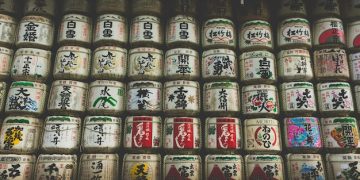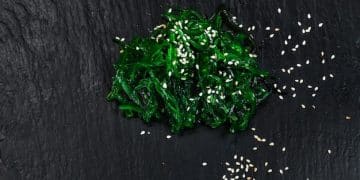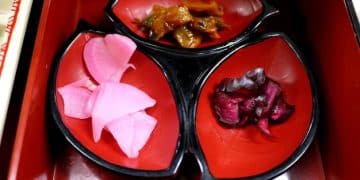Sake Secrets: Decoding Labels for Perfect Pairings in 2025
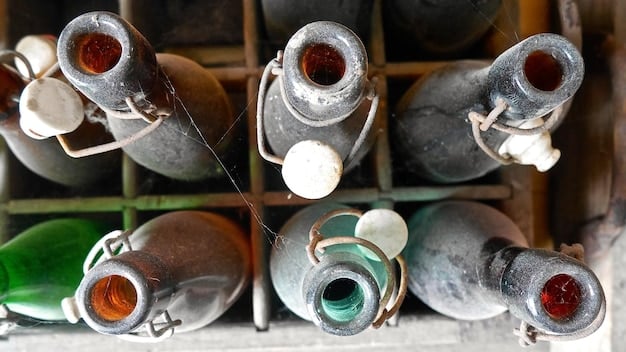
Sake Secrets: Decoding Japanese Rice Wine Labels for the Perfect Pairing in 2025 involves understanding the intricate details on sake bottles, including production methods, rice types, and polishing ratios, to select the ideal sake for enhancing specific culinary experiences.
Embark on a flavorful journey into the world of Japanese rice wine, where understanding the nuances of sake labels is key to unlocking the perfect food pairing. In Sake Secrets: Decoding Japanese Rice Wine Labels for the Perfect Pairing in 2025, we’ll navigate the cryptic world of kanji and technical terms, transforming you from a novice into a sake aficionado ready to impress at your next dinner party.
Understanding the Basics of Sake: What is Japanese Rice Wine?
Before diving into the intricacies of sake labels, it’s essential to understand the fundamentals of this iconic Japanese beverage. Sake, often referred to as rice wine, is actually brewed, not fermented like grape wine. Its production process shares similarities with beer, involving the fermentation of rice.
The key ingredients in sake are rice, water, koji (a type of mold used to convert rice starch into sugar), and yeast. The quality of these ingredients, along with the brewer’s expertise, significantly impacts the final product.
The Brewing Process: A Brief Overview
The sake brewing process is a meticulous and time-honored tradition. Here’s a simplified breakdown:
- Rice Polishing (Seimai): Rice grains are polished to remove the outer layers, which contain fats and proteins that can detract from the sake’s flavor. The polishing ratio is a crucial factor in determining the sake’s grade and quality.
- Koji Making (Koji-Tsukuri): Koji mold is cultivated on steamed rice, converting the rice starch into fermentable sugars. This step is critical for the sake’s flavor profile.
- Yeast Starter (Moto or Shubo): A yeast starter is prepared to cultivate a healthy and strong yeast culture. This ensures a consistent and controlled fermentation.
- Main Fermentation (Moromi): The koji, yeast starter, and additional steamed rice and water are combined in a tank to undergo fermentation. This process can last for several weeks.
- Pressing (Joso): After fermentation, the sake is pressed to separate the liquid from the rice solids.
- Filtration, Pasteurization, and Aging: The sake is filtered, pasteurized to kill any remaining microorganisms, and aged for a period of time to develop its flavors.
Understanding these basic steps provides a foundation for appreciating the information conveyed on sake labels and how they relate to the final flavor and character of the sake.
Deciphering the Sake Label: Key Terms and Classifications
Sake labels are often adorned with Japanese characters (kanji and kana), which can seem daunting to the uninitiated. However, once you understand the key terms and classifications, you’ll be well on your way to selecting the perfect sake. Knowing how to read these labels is a crucial part of understanding Sake Secrets: Decoding Japanese Rice Wine Labels for the Perfect Pairing in 2025.
Here are some of the most important terms you’ll encounter:
Premium vs. Non-Premium Sake: The Grade Matters
Sake is broadly classified into two main categories: premium (Tokutei Meisho-shu) and non-premium (Futsū-shu). Premium sake represents the top tier of sake production, adhering to strict regulations and utilizing high-quality ingredients. Non-premium sake accounts for the majority of sake produced and is often more affordable.
Key Classifications to Look For
- Junmai (純米): This term indicates that the sake is made using only rice, water, koji, and yeast. No additional alcohol is added. Junmai sake often has a richer, more full-bodied flavor.
- Honjozo (本醸造): This type of sake has a small amount of distilled alcohol added to enhance its flavor and aroma. Honjozo sake is typically lighter and drier than Junmai sake.
- Ginjo (吟醸): Ginjo sake is made using rice that has been polished to at least 60% of its original size. It is fermented at low temperatures using special yeast strains, resulting in a fragrant and delicate flavor profile.
- Daiginjo (大吟醸): Daiginjo sake is the highest grade of sake, made using rice that has been polished to at least 50% of its original size. It boasts an even more refined and complex aroma and flavor than Ginjo sake.
In summary, understanding these classifications helps you quickly assess the quality and characteristics of a sake, guiding you towards choices that align with your preferences and food pairings.
The Importance of Rice Polishing Ratio (Seimaibuai)
The rice polishing ratio, or Seimaibuai (精米歩合), is a critical indicator of sake quality and flavor. It represents the percentage of the original rice grain that remains after polishing. This is essential knowledge for fully understanding Sake Secrets: Decoding Japanese Rice Wine Labels for the Perfect Pairing in 2025.
A lower polishing ratio indicates that more of the outer layers of the rice grain have been removed, resulting in a purer, more refined sake. Generally, sake with a lower polishing ratio is considered to be of higher quality.
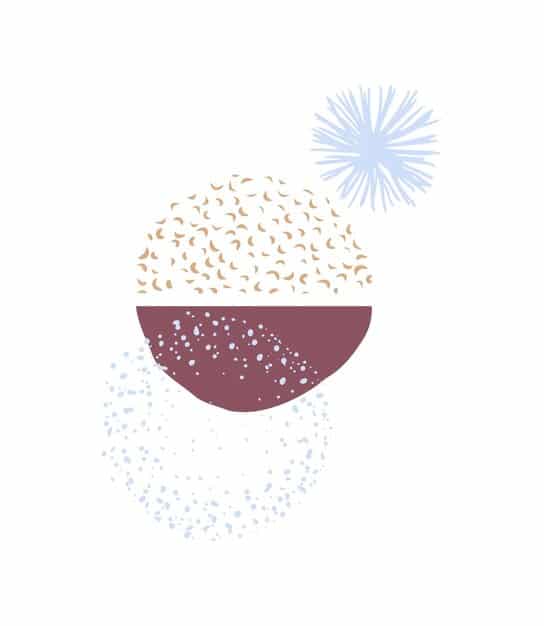
What Does the Polishing Ratio Tell You?
The polishing ratio directly impacts the sake’s flavor profile. The outer layers of the rice grain contain fats, proteins, and amino acids that can contribute to undesirable flavors. By removing these layers, brewers can produce sake that is cleaner, more aromatic, and more nuanced.
For example, Daiginjo sake, with a polishing ratio of 50% or less, tends to exhibit delicate floral and fruity aromas. In contrast, sake with a higher polishing ratio may have a more robust and earthy flavor.
How to Find the Polishing Ratio on the Label
The polishing ratio is typically indicated on the sake label as “Seimaibuai” followed by a percentage. If the label is entirely in Japanese, look for the characters 精米歩合 followed by a number. For instance, 精米歩合50% would indicate a polishing ratio of 50%.
Understanding the polishing ratio empowers you to make informed decisions about sake selection, allowing you to choose sake that aligns with your desired flavor profile and pairing goals.
Sake Meter Value (SMV) and Acidity: Decoding Flavor Profiles
The Sake Meter Value (SMV), or Nihonshu-do (日本酒度), and acidity levels are two important metrics that provide insights into a sake’s flavor profile. Understanding these values enhances your ability to decode Sake Secrets: Decoding Japanese Rice Wine Labels for the Perfect Pairing in 2025 and make informed choices.
The SMV indicates the sake’s relative sweetness or dryness, while acidity contributes to its overall balance and complexity.
Sake Meter Value (SMV): Sweet or Dry?
The SMV is a numerical scale that ranges from negative to positive numbers. A positive SMV indicates a drier sake, while a negative SMV indicates a sweeter sake. The higher the positive number, the drier the sake; the lower the negative number, the sweeter the sake.
When trying to understand if a sake will be sweet or dry, remember the following points:
- A value of +5 or higher suggests a distinctly dry flavor.
- A value around 0 suggests a balanced sake.
- A value of -5 or lower suggests a sweeter taste.
Acidity: Adding Balance and Complexity
Acidity plays a crucial role in balancing the sweetness and dryness of sake. It contributes to the sake’s overall complexity and mouthfeel. Higher acidity can make a sake feel more crisp and refreshing, while lower acidity can result in a smoother, rounder texture.
This balance is important when pairing sake with food, as it can compliment or contrast the dish’s flavors, enhancing the dining experience with the drink:
- Sake with high acidity pairs well with rich, fatty dishes, cutting through the richness and cleansing the palate.
- Sake with low acidity pairs well with delicate, subtle flavors, complementing the dish without overpowering it.
- The balance of both acidity and sweetness will also change the effect sake has with your food.
While the SMV and acidity levels may not always be prominently displayed on sake labels, they are valuable pieces of information for understanding a sake’s flavor profile and making informed pairing decisions.
Pairing Sake with Food: Creating Culinary Harmony
The art of pairing sake with food is all about creating harmony and balance between the flavors. Just like wine, sake can enhance the dining experience by complementing or contrasting the flavors of the dish. This is where your understanding of Sake Secrets: Decoding Japanese Rice Wine Labels for the Perfect Pairing in 2025 truly comes to life.
Consider the sake’s characteristics, such as its grade, polishing ratio, SMV, and acidity, when selecting a pairing.
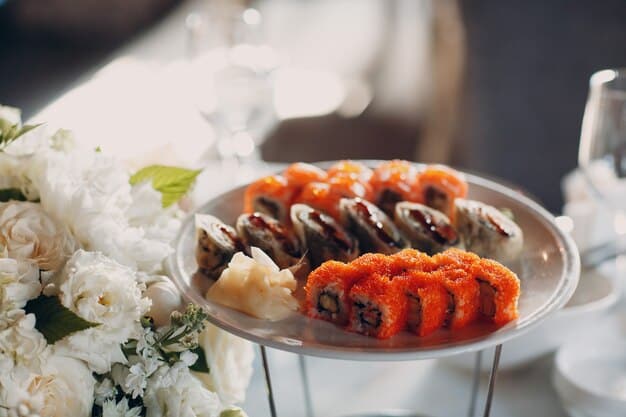
General Pairing Guidelines
To elevate your culinary experience with sake, here are a few pairing guidelines:
- Daiginjo: This premium sake pairs exceptionally well with delicate flavors such as sashimi, oysters, and light salads. Its refined aroma and flavor enhance these subtle dishes.
- Ginjo: Ginjo sake complements slightly richer dishes such as grilled fish, tempura, and seafood pasta. Its balanced acidity and fruity notes provide a refreshing contrast.
- Junmai: Junmai sake pairs well with hearty, umami-rich dishes such as grilled meats, teriyaki, and aged cheeses. Its full-bodied flavor stands up to these bolder flavors.
- Honjozo: Honjozo sake is a versatile pairing option that complements a wide range of dishes, from sushi and yakitori to ramen and gyoza. Its light and dry character makes it a refreshing accompaniment.
Experimentation is Key
While these guidelines provide a good starting point, don’t be afraid to experiment and discover your own favorite pairings. Sake can be enjoyed with a wide variety of cuisines, from Japanese to Western, so explore the possibilities and trust your palate.
By understanding the characteristics of sake and the principles of food pairing, you can create truly memorable culinary experiences that showcase the versatility and complexity of this iconic Japanese beverage.
Navigating Sake Selection in 2025: Trends and Innovations
The world of sake is constantly evolving, with new trends and innovations emerging that shape the way we enjoy this beloved beverage. As we look ahead to 2025, it’s important to stay informed about these developments to fully appreciate Sake Secrets: Decoding Japanese Rice Wine Labels for the Perfect Pairing in 2025.
From sustainable practices to innovative brewing techniques, the future of sake is bright and exciting.
Emerging Trends in Sake Production
As we move towards the year 2025, the sake industry is embracing a variety of trends that are modernizing and diversifying the brewing process. Some of these include:
Here are some exciting developments to watch for:
- Sustainability: Many sake breweries are adopting sustainable practices, such as using locally sourced rice, reducing water consumption, and minimizing waste. Look for sake labels that highlight these eco-friendly initiatives.
- Unique Rice Varieties: Brewers are experimenting with different rice varieties beyond the traditional Yamada Nishiki, resulting in sake with unique flavor profiles.
- Aging Techniques: Innovative aging techniques, such as aging sake in different types of wood barrels, are creating sake with complex and nuanced flavors.
The Future of Sake Labels
As consumers become more knowledgeable about sake, labels are evolving to provide more detailed information about the brewing process, ingredients, and flavor profile. Expect to see more labels that include detailed tasting notes, pairing suggestions, and information about the brewery’s history and philosophy.
By staying informed about these trends and innovations, you can navigate the sake selection process with confidence and discover new and exciting sake that perfectly matches your preferences and culinary adventures.
| Key Concept | Brief Description |
|---|---|
| 🍶 Sake Basics | Fermented rice beverage; brewed like beer, not wine. |
| 🍚 Rice Polishing | Removal of outer rice layers; lower ratio = higher quality. |
| 🌡️ SMV & Acidity | SMV indicates sweetness/dryness; acidity adds balance. |
| 🍽️ Food Pairing | Match sake character to dish flavors for harmony and balance. |
Frequently Asked Questions about Sake
▼
Sake is a specific type of alcoholic beverage made from fermented rice. While often called rice wine, it’s brewed more like beer. The term “rice wine” can refer to various beverages, while sake has a defined production process.
▼
Sake can be served chilled, at room temperature, or warm, depending on the type and your personal preference. Generally, premium sake is best enjoyed chilled or at room temperature to appreciate its delicate flavors.
▼
“Junmai” indicates that the sake is made using only rice, water, koji, and yeast, with no added alcohol. Known for their rich, full-bodied flavor, “Junmai” sake does not include any additives.
▼
The rice polishing ratio is very important as it directly impacts the sake’s flavor profile. The lower the polishing ratio, the more refined the sake will be. It also affects the price, with lower ratios generally more expensive.
▼
Unopened sake can be stored in a cool, dark place for up to a year. Once opened, it should be refrigerated and consumed within a week to maintain its freshness and flavor. Keep away from direct sunlight.
Conclusion
Decoding sake labels is an enlightening journey that enhances your appreciation for this exquisite Japanese beverage. By understanding the key terms, classifications, and flavor indicators, you can confidently navigate the world of sake and create unforgettable food pairings in 2025 and beyond.
